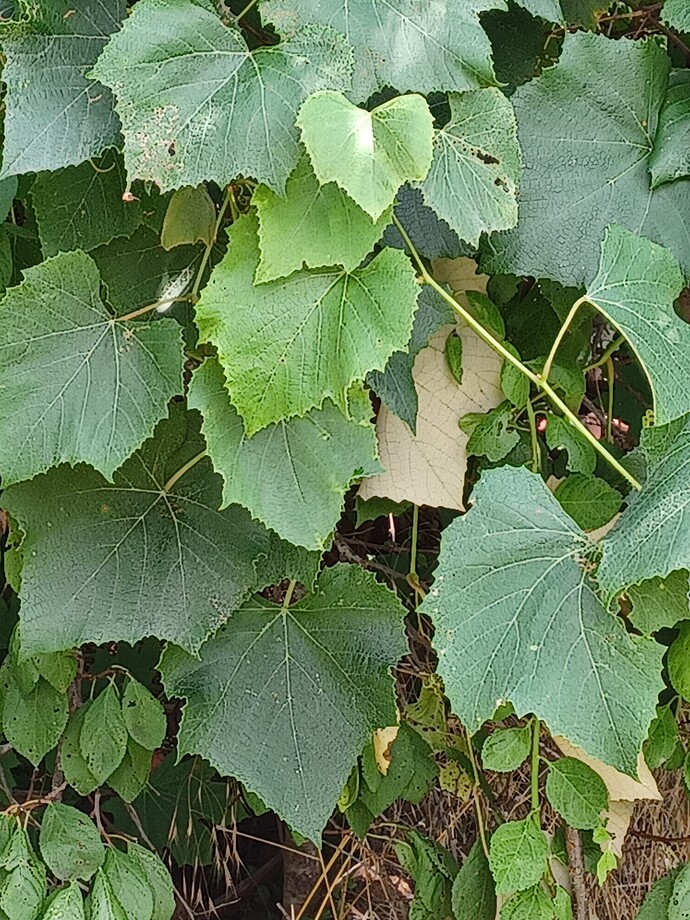Any ideas what grape variety this is?
I found it in zone 6b West Virginia. It’s a old vine I found growing in the yard of a abandoned house growing around some small trees. I’m sure the original support trellis rotted away a long time ago. They are very sweet with only one small seed. They were ripe last year on August 30th. I took cuttings from it over the winter and have one growing in a pot.
My 80 year old concord looks like those.
The ‘bloom’ looks excessive. But I suppose it could still be Concord. (Different climate, different years, so more photos and info needed to be positive. Concord being a common old variety, it is a good guess.)
Very likely that it could be Campbell’s Early which is from Ohio and is a very old cultivar that is very hardy.
To be sure…this year as you say on August 30… they are ripe. You need to look at when they color up fully…then one week after that they should be fully ripe.
Its season is very early often showing color late in July, and ripening,
according to the season, from the fifteenth to the last of August, at Delaware,
Ohio.
Good thought…Campbell’s. Maybe?
His grapes in the original post asking for an ID have so much blue bloom, I think I’ve only seen wild grapes the size of large peas exhibit this much of that blue look…or possibly a French hybrid.
Thank you both for the help.
Im going to get some more pictures. There are loads of wild grapes all around near where i found it but like you said @BlueBerry they are only pea sized and sour not nearly as sweet or as large as the grapes in the original post.
Any characteristics that i should look for an take pictures of to help identify?
Do you all think it could be a variety of Vitus Labrusca similar to Concord and the older blue Worden not the newer purple interspecific Worden?
Many concord type grapes have distinguished concord flavor/or aroma, does your grape have it?Also, concord is slip skin, does your grape match that?
It is slip skin
I went back to where i found the grapevine and noticed some of the vines laying on the ground had self rooted so we pulled a few up an potted them in 2 gallon pots. I sealed the top cut end with wood glue. Ill store them in the garage this winter. I hope i pulled up enough roots for them to survive. An hopefully its not to late in the season also not dormant. What do you all think?
This is a cutting I rooted from it over the winter its really doing good.
@clarkinks grows Concords… and i think its been mentioned alot of times that often the seedless Concord will put out a few seeds depending on climate etc.
You should compare with someone that grows Concord to get a better idea of ripening times.
The Concord grape is native to North America, and was first selected and propagated from wild seedlings by Ephraim Bull in Concord, Massachusetts in 1849.
So your story easily fits this narrative.
Im growing some Mars myself…its one of the most disease resistant varieties…high yields and some have said may be a replacement for Concord. They sell it at Walmart and Lowes in March if u ever want to try it. (i am not very good at growing grapes and dont want to get too big time into it… so im just letting them go on a cattle panel like Clark does his).
They are a concord type grape which i know by the whitish / yellowish colored underside of the leaf. They may be a seedling or may be concord itself but they will have that wonderful juice flavor we all love. Concord Juice is very high in antioxidants and vitamins!
This doesn’t really help with identifying the exact variety, but labrusca and hybrids with a high percentage of labrusca parentage will have a tendril opposite nearly every leaf. For the vast majority of other grapes, there will be a repeating pattern of two nodes with tendrils followed by a blank. Varieties of mixed labrusca parentage may or may not have a blank node between tendrils.
Concord, and pretty much all other labrusca varieties in commerce, actually have some European grape ancestry. All wild grapes have separate male and female vines. The gene for hermaphroditic flowers in American grape varieties (besides muscadines) comes from a European grape, as does seedlessness. It’s very common to have gene flow from vineyards into the surrounding native grape population. Here in California’s wine country, there are virtually no pure Vitis californica vines left.
You take your chances…no guarrantees on rooting or survival. Sometimes it succeeds.
Agree that Campbell’s Early, aka Island Belle, is a good possibility. Not many labrusca types with fruit that large, and it was a very popular variety before seedless grapes came along.
Seedless concord ripe in TN… August 24.
Mine truly are seedless… but the fruit and clusters are both on the small side.
Intense flavor, plenty sweet.
I have to organza bag them or the birds will get nearly every one.
This is what they look like July 22… ignore that pretty apple ![]()
@krismoriah thank you. im also going to make a cattle panel trellis
@clarkinks thank you. It really is a delicious grape i cant wait to get it growing.
@GrapeNut thank you for your help
@BlueBerry hopefully they pull through
@TNHunter those look delicious!
Do your seedless concord sometimes produce a small second crop like mine do? Nearly every year i get 2 crops.
@clarkinks … mine do not 2nd crop.
Mine ripen slowly over a month or more just a few at a time.




















